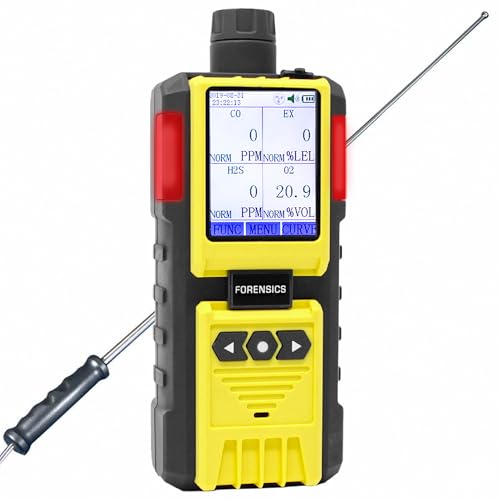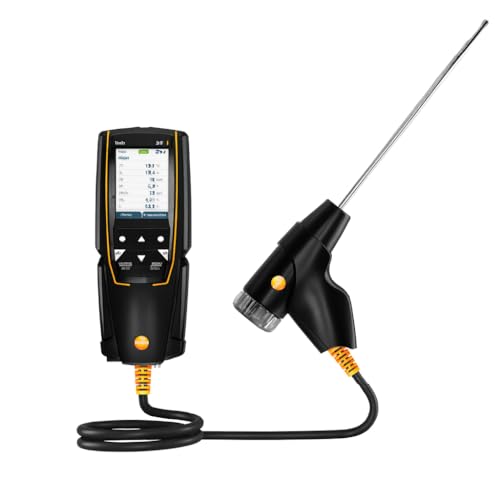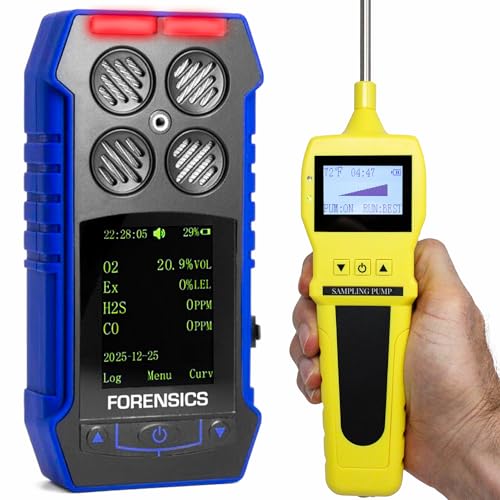When it comes to choosing the right blood gas analyzer for your clinic, you need to take into account several key factors. Portability, speed, and calibration accuracy can considerably impact patient care. In this guide, we’ll explore ten top models that excel in these areas. You’ll find the best options tailored to enhance clinical efficiency and guarantee reliable results. Curious to see which analyzers made the list and how they can benefit your practice?
Forensics 4 Gas Monitor with Built-in Pump
The Forensics 4 Gas Monitor with Built-in Pump is an essential tool for clinics and professionals who require precise monitoring of hazardous gases like Oxygen, Carbon Monoxide, Hydrogen Sulfide, and Combustibles. Its robust design features a built-in pump and a 4-foot probe, making it waterproof, dust-proof, and explosion-proof. The color display offers graphing functions for easy data interpretation, while its computer logging capability stores up to 1200 alarm records. With USA NIST traceable calibration and a 1-year limited warranty, you can trust its reliability. The compact size and lightweight nature guarantee portability, making it an ideal choice for your needs.
Best For: The Forensics 4 Gas Monitor is best for clinics and professionals who require accurate monitoring of hazardous gases in demanding environments.
Pros:
- Robust and durable design: Waterproof, dust-proof, and explosion-proof, ensuring reliability in various conditions.
- User-friendly interface: Color display with graphing functions for intuitive operation and easy data interpretation.
- Extensive data storage: Capable of logging up to 1200 alarm records for comprehensive monitoring and analysis.
Cons:
- Concerns about accuracy: Some users have reported issues with the precision of Hydrogen Sulfide (H2S) detection.
- Weight: At 14.4 ounces, it may be heavier than other portable gas monitors.
- Limited warranty: The 1-year limited warranty may be seen as insufficient for long-term use.
Forensics Detectors 4 Gas Monitor + Pump
For those working in confined spaces or needing precise point sampling, the Forensics Detectors 4 Gas Monitor + Pump stands out as an essential tool. It features high-quality sensors for Oxygen, Carbon Monoxide, Hydrogen Sulfide, and Combustibles. Its robust design includes waterproof and dust-proof capabilities, ensuring durability in challenging environments. With adjustable alarms and a digital logging system, you’ll stay informed about gas levels. The monitor operates on two Lithium Ion batteries, offering about 10 hours of use, and it’s easily rechargeable via USB. Plus, it comes with a 1-year warranty, ensuring peace of mind for your safety needs.
Best For: Professionals working in confined spaces or performing point sampling who require reliable gas detection.
Pros:
- High-quality sensors for detecting Oxygen, Carbon Monoxide, Hydrogen Sulfide, and Combustibles.
- Robust and durable design that is waterproof, dust-proof, and explosion-proof.
- Adjustable alarms and digital logging provide comprehensive monitoring of gas levels.
Cons:
- Average battery life of 10 hours may require frequent recharging for extended use.
- Some users express concerns about precision, suggesting it may not be suitable for critical applications.
- Calibration every 6 months is recommended, which can add to maintenance costs.
Forensics Nitrogen Gas Detector
If you’re in need of a reliable solution for detecting nitrogen gas leaks, the Forensics Nitrogen Gas Detector stands out with its high-quality electrochemical oxygen sensor. This portable analyzer is lightweight at just 14.4 ounces and features a rugged design that’s water, dust, and explosion resistant. You’ll appreciate the color screen and real-time data acquisition capabilities, making it easy to monitor and log data. With a one-year warranty and USA NIST calibration, you can trust its accuracy. Plus, it includes handy accessories like silicone tubing and a stainless probe for thorough leak detection.
Best For: Professionals in industrial settings needing a reliable and portable solution for nitrogen gas leak detection.
Pros:
- High-quality electrochemical oxygen sensor ensures accurate leak detection.
- Lightweight and portable design makes it easy to carry and use in various environments.
- Robust construction with resistance to water, dust, and explosions enhances durability.
Cons:
- Battery-powered design may require frequent recharging during extensive use.
- Limited to nitrogen gas detection, which may not suit all gas leak detection needs.
- Price may be higher compared to basic gas detectors without advanced features.
Portable Gas Detector, Gas Clip 4 Gas Monitor
Ideal for medical professionals and clinic staff, the Portable Gas Detector, Gas Clip 4 Gas Monitor offers a reliable solution for monitoring air quality in various environments. This rechargeable device detects combustible gases, oxygen, carbon monoxide, and hydrogen sulfide, ensuring your safety with a response time of under 30 seconds. Its durable, waterproof design and lightweight build make it easy to carry. With adjustable alarm modes, including audio and vibration alerts, you’ll stay informed of potential hazards. Powered by a rechargeable battery, it’s backed by a one-year warranty, providing peace of mind while you focus on patient care.
Best For: Medical professionals and clinic staff seeking a reliable air quality monitoring solution.
Pros:
- Durable Design: Waterproof, dust-proof, and explosion-proof, ensuring longevity and reliability in various environments.
- Quick Response Time: Detects gases with a response time of under 30 seconds, providing timely alerts for potential hazards.
- Adjustable Alarms: Features customizable audio, visual, and vibration alarms to suit user preferences and enhance safety awareness.
Cons:
- Battery Life Issues: Some users report concerns about the battery not holding a charge effectively.
- Sensor Accuracy Problems: There are reports of devices registering 0 ppm or 0.0% for gases, raising concerns about reliability.
- Alarm Functionality Challenges: Some users have experienced difficulties with alarm settings and muting options.
testo Combustion Analyzer 310 II
The testo Combustion Analyzer 310 II stands out as an essential tool for plant mechanics and HVAC professionals who need reliable flue and exhaust gas analysis. With its intuitive menu and smart app, you can easily measure key parameters like O2, temperature, and efficiency. The highly sensitive sensors guarantee precise readings, while the robust design withstands harsh environments. You’ll appreciate the hands-free operation with magnetic attachment and quick sensor zeroing. Plus, the Smart App enables remote operation and easy data management. With excellent customer reviews, this analyzer proves to be both efficient and dependable for all your maintenance needs.
Best For: The testo Combustion Analyzer 310 II is best for plant mechanics and HVAC professionals requiring reliable flue and exhaust gas analysis.
Pros:
- User-friendly interface with an intuitive menu for efficient operation.
- Highly sensitive sensors ensure precise measurements of key parameters.
- Smart App functionality allows for remote operation and seamless data management.
Cons:
- May require additional training for those unfamiliar with combustion analyzers.
- The weight of 1.5 pounds may be cumbersome for some users during extended use.
- Additional costs for optional accessories like the Testo quick printer may be necessary.
TopTes Guard-101 Gas Detector (4 Gas Monitor)
For those in industries where gas exposure is a constant concern, the TopTes Guard-101 Gas Detector shines as a reliable companion. This 4-gas monitor detects H2S, CO, LEL, and O2 with a rapid response time of just 0.5 seconds. Its long-lasting battery can run for up to 14 hours, ensuring you stay protected throughout your shifts. The device features an intuitive design, is waterproof, dustproof, and explosion-proof, and includes a back clip for easy transport. With triple alarm modes and data storage, you’ll always be aware of gas concentrations. Plus, it comes with a 36-month warranty for added peace of mind.
Best For: The TopTes Guard-101 Gas Detector is best for professionals working in environments with potential gas exposure, such as industrial manufacturing, mining, and emergency rescue.
Pros:
- Quick detection with a response time of just 0.5 seconds.
- Long battery life of up to 14 hours for extended use.
- Equipped with triple alarm modes (LED, vibration, sound) for effective alerts.
Cons:
- Some users have reported issues with defective units.
- May require careful handling due to its sensitivity and calibration needs.
- The design may be bulkier than other portable gas detectors on the market.
Forensics USA NIST Calibrated 4 Gas Monitor
If you’re looking for a reliable gas monitor for your clinic or forensic environment, the Forensics USA NIST Calibrated 4 Gas Monitor is an excellent choice. It accurately measures O2, CO, H2S, and combustibles with a detection error of ≤±5% F.S. This portable device features a USB rechargeable battery lasting around six hours and boasts a robust, waterproof design. With adjustable alarms and a clear digital timestamp, you can stay informed of gas levels. Despite mixed reviews on accuracy, many users praise the responsive customer service. Overall, it’s a solid option for ensuring safety in your workspace.
Best For: Professionals in clinics or forensic environments seeking a reliable gas monitoring solution for safety.
Pros:
- High-quality electrochemical sensors with precise detection error of ≤±5% F.S.
- USB rechargeable with an average battery life of 6 hours, ensuring portability and convenience.
- Robust, waterproof, and explosion-proof design for durability in various conditions.
Cons:
- Mixed customer reviews regarding accuracy and ease of use.
- Some users have reported charging issues with the device.
- Customer feedback indicates variability in performance, leading to potential concerns for critical applications.
Multigas 4 Gas Monitor with NIST Calibration Certificate
Designed with healthcare professionals in mind, the Multigas 4 Gas Monitor offers precise detection of critical gases like Oxygen, Carbon Monoxide, Hydrogen Sulfide, and Combustibles. Its vibrant color screen and graph functions make data interpretation straightforward. This monitor comes with a USA NIST factory calibration, ensuring accuracy and reliability. Plus, its data logging capabilities allow you to track measurements over time. Built from high-strength ABS with an anti-slip grip, it’s robust and user-friendly. You’ll appreciate the 1-year limited warranty, along with the included calibration and QA certificate for peace of mind in your clinical settings.
Best For: Healthcare professionals needing reliable gas detection for safety and monitoring in clinical environments.
Pros:
- Accurate detection of critical gases (O2, CO, H2S, Combustibles) with USA NIST factory calibration.
- User-friendly design featuring a vibrant color screen and graph functions for easy data interpretation.
- Durable construction with high-strength ABS and an anti-slip grip for enhanced handling in various settings.
Cons:
- Limited to four gas detection capabilities, which may not cover all specific needs in certain industries.
- The 1-year warranty may be shorter than what some users expect for high-tech equipment.
- Data logging may require additional software or tools for comprehensive analysis over time.
MULTIGAS Detector Analyzer with Pump and Probe
The MULTIGAS Detector Analyzer with Pump and Probe is an ideal choice for clinics that require reliable and efficient gas monitoring. This robust device, made from high-strength ABS, is waterproof, dust-proof, and explosion-proof, ensuring durability in various environments. With its electrochemical sensors, you can monitor four gases and benefit from computer data logging. The color display makes operation straightforward, while audible and visual alarms keep you informed. Pre-calibrated and battery-powered with included lithium-ion batteries, it’s ready for immediate use. Plus, it comes with a one-year warranty, ensuring peace of mind for your clinic’s gas detection needs.
Best For: Clinics and facilities that require a reliable, durable, and efficient gas monitoring solution.
Pros:
- Robust design made from high-strength ABS, ensuring durability and resistance to various environmental conditions.
- Easy-to-use color display with graph functions and pre-calibrated for immediate operation.
- Includes USB data logging capability and a one-year warranty for added peace of mind.
Cons:
- Some users reported limitations in measuring specific gases, such as O2.
- Best sellers rank indicates it may not be the top choice among all gas detectors available.
- The weight of 400 grams may be considered bulky for portable applications.
4 in 1 Gas Detector, Rechargeable Portable Gas Monitor
For healthcare professionals seeking a reliable and versatile tool, the Vzmcov 4 in 1 Gas Detector stands out as an ideal choice. This rechargeable portable gas monitor accurately measures multiple gases, ensuring high sensitivity and factory calibration. Weighing just 0.95 pounds and compact in size, it’s easy to carry around. With audible, visual, and vibration alarms, you’ll never miss a critical alert. The detector operates effectively in humid conditions and comes with a lithium battery for convenience. With a solid rating of 4.4 stars from users, it proves its effectiveness in detecting low oxygen levels and has reliable battery life.
Best For: Healthcare professionals and safety personnel requiring a reliable and portable gas detection solution.
Pros:
- High sensitivity and accuracy with factory calibration.
- Compact and lightweight design for easy portability.
- Multiple alarm types (audible, visual, and vibration) ensure critical alerts are noticeable.
Cons:
- Calibration checks may be needed for optimal performance.
- Battery life may be limited under certain conditions.
- Sensitivity issues could arise in extreme temperatures.
Factors to Consider When Choosing a Blood Gas Analyzer for Clinics
When you’re selecting a blood gas analyzer for your clinic, you’ll want to contemplate several key factors. Accuracy and speed can greatly impact your patient care, while a user-friendly interface makes operation smoother. Don’t forget to take into account calibration needs and the device’s portability, as these features can enhance your workflow.
Accuracy and Precision
Choosing a blood gas analyzer with high accuracy and precision is important for any clinic aiming to provide reliable patient care. Look for analyzers with a detection error of ≤±5% to guarantee trustworthy results. It’s essential that the analyzer comes with a traceable calibration certificate, as precise calibration is key to maintaining accuracy. Additionally, consider how well the device performs in varying temperature and humidity conditions; reliable models typically operate effectively at up to 95% humidity. Regular maintenance, including recalibrating every six months, is crucial for ongoing precision. Finally, verify the response time is under 30 seconds, allowing for timely interventions in critical care situations, which can greatly influence patient outcomes.
Speed of Analysis
While timely diagnosis and treatment are essential in clinical settings, the speed of analysis in blood gas analyzers plays an important role in achieving these outcomes. Quick results, often within minutes, can greatly enhance patient care, particularly in emergencies where rapid decision-making is vital. When choosing an analyzer, look for high-performance models that deliver results for multiple parameters, such as pH, pCO2, pO2, and bicarbonate levels, efficiently. Some advanced analyzers can provide accurate readings in as little as 60 seconds. Fast analysis is supported by automated processes and advanced sensors, which help minimize human error and increase the reliability of test results. Prioritizing speed can lead to better patient outcomes in your clinic.
User-Friendly Interface
Fast analysis in blood gas testing is only part of the equation; the user interface of the analyzer greatly impacts how effectively you can interpret results and make decisions. A user-friendly interface often features a color display with intuitive navigation, helping you quickly grasp essential information. Touchscreen controls and customizable settings allow you to tailor the analyzer to your preferences, enhancing usability. Built-in graphical displays offer real-time data visualization, improving your understanding of complex results and speeding up decision-making. Streamlined workflows reduce testing time and minimize user errors in high-pressure environments. Additionally, clear alarm notifications and visual indicators for critical values guarantee you can respond promptly to abnormal results, ultimately enhancing patient safety and care quality.
Calibration Requirements
When it comes to blood gas analyzers, understanding calibration requirements is vital for guaranteeing accurate measurements. Calibration typically involves using known standards or reference materials, so you can trust your results. Regular calibration intervals, like every six months, help maintain accuracy and meet regulatory standards. Look for analyzers that utilize USA NIST traceable calibration; this guarantees reliability and consistency across devices. Always perform calibration according to the manufacturer’s specifications to avoid discrepancies in your results. Additionally, implementing quality assurance protocols, including calibration and QA certificates, is essential for verifying the performance of your analyzer in a clinical setting. Choosing a device with robust calibration features will enhance your confidence in its accuracy.
Portability and Size
Portability is a key factor to consider when choosing a blood gas analyzer for your clinic, especially if you need to move it between various patient care areas. Compact and lightweight designs make it easier to transport, saving valuable time during critical situations. A smaller footprint not only conserves space but also allows for convenient storage in fast-paced environments. Many portable analyzers operate on battery power, giving you flexibility in areas without immediate electrical access. When evaluating dimensions, verify the analyzer fits well in your workspace without disrupting workflow. Features like rugged construction and easy-to-carry handles enhance usability, making it simpler to navigate the dynamic demands of clinical settings. Prioritize portability to improve efficiency and patient care.
Maintenance and Support
Choosing the right blood gas analyzer for your clinic involves more than just considering its portability and size; maintenance and support play a significant role in guaranteeing long-term reliability and accuracy. Regular maintenance is key, requiring calibration and sensor checks every 6 to 12 months based on the manufacturer’s guidelines. Look for analyzers that come with at least a one-year warranty, covering repairs or replacements for defects. Technical support is essential too, as it helps you troubleshoot issues and understand the device’s functionality. Confirm documentation like calibration certificates and quality assurance records is accessible to verify performance. Additionally, prioritize user training and ongoing education to enhance the analyzer’s longevity and effectiveness in your clinical setting.
Cost and Budget
Understanding the cost implications is essential for ensuring that a blood gas analyzer fits your clinic’s budget. Start with the initial purchase price, which can vary greatly depending on features, technology, and brand reputation. Don’t forget to factor in ongoing expenses such as maintenance, calibration, and consumables. Evaluating the total cost of ownership is vital; consider potential training costs and how the analyzer will integrate into your existing workflows. Some models offer financing or leasing options, making them easier to manage within tight budgets. Finally, compare warranty lengths and customer support services, as better support can greatly reduce long-term operational costs. Making informed choices now can save you money in the long run.









